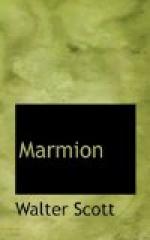“Britain heard
the descant bold,
She flung her
white arms o’er the sea,
Proud in her leafy
bosom to enfold
The freight of
harmony."’-Scott.
line 58. For = instead of.
lines 60-1. gleam’st, with trans. force, is an Elizabethanism. Cp. Shakespeare’s Lucrece, line 1378:—
‘Dying eyes gleamed forth their ashy lights.’
line 67. See ‘Faerie Queene,’ iii. iv.
line 78. “For every one her liked, and every one her loved.” Spenser, as above.’—Scott.
line 106. A knosp is an architectural ornament in form of a bud.
lines 111-12. See Genesis xviii.
line 118. ’Henry vi, with his Queen, his heir, and the chiefs of his family, fled to Scotland after the battle of Towton. In this note a doubt was formerly expressed whether Henry vi came to Edinburgh, though his Queen certainly did; Mr. Pinkerton inclining to believe that he remained at Kirkcudbright. But my noble friend, Lord Napier, has pointed out to me a grant by Henry, of an annuity of forty marks to his Lordship’s ancestor, John Napier, subscribed by the King himself, at Edinburgh, the 28th day of August, in the thirtyninth year of his reign, which corresponds to the year of God, 1461. This grant, Douglas, with his usual neglect of accuracy, dates in 1368. But this error being corrected from the copy of Macfarlane’s MSS., p. 119, to, removes all scepticism on the subject of Henry vi being really at Edinburgh. John Napier was son and heir of Sir Alexander Napier, and about this time was Provost of Edinburgh. The hospitable reception of the distressed monarch and his family, called forth on Scotland the encomium of Molinet, a contemporary poet. The English people, he says,—
“Ung nouveau roy creerent,
Par despiteux vouloir,
Le vieil en debouterent,
Et son legitime hoir,
Qui fuytyf alia prendre
D’Ecosse le garand,
De tous siecles le mendre,
Et le plus tollerant.”
Recollection des Avantures’—Scott.
line 120. ’In January, 1796, the exiled Count d’Artois, afterwards Charles X of France, took up his residence in Holyrood, where he remained until August, 1799. When again driven from his country, by the revolution of July, 1830, the same unfortunate Prince, with all the immediate members of his family, sought refuge once more in the ancient palace of the Stuarts, and remained there until 18th September, 1833.’—Lockhart.
line 140. ’Mr. Ellis, in his valuable Introduction to the “Specimens of Romance,” has proved, by the concurring testimony of La Ravaillere, Tressan, but especially the Abbe de la Rue, that the courts of our Anglo-Norman Kings, rather than those of the French monarch, produced the birth of Romance literature. Marie, soon after mentioned, compiled from Armorican originals, and translated into Norman-French, or Romance language, the twelve curious Lays of which Mr. Ellis has given us a precis in the Appendix to his Introduction. The story of Blondel, the famous and faithful minstrel of Richard I, needs no commentary.’—Scott.




